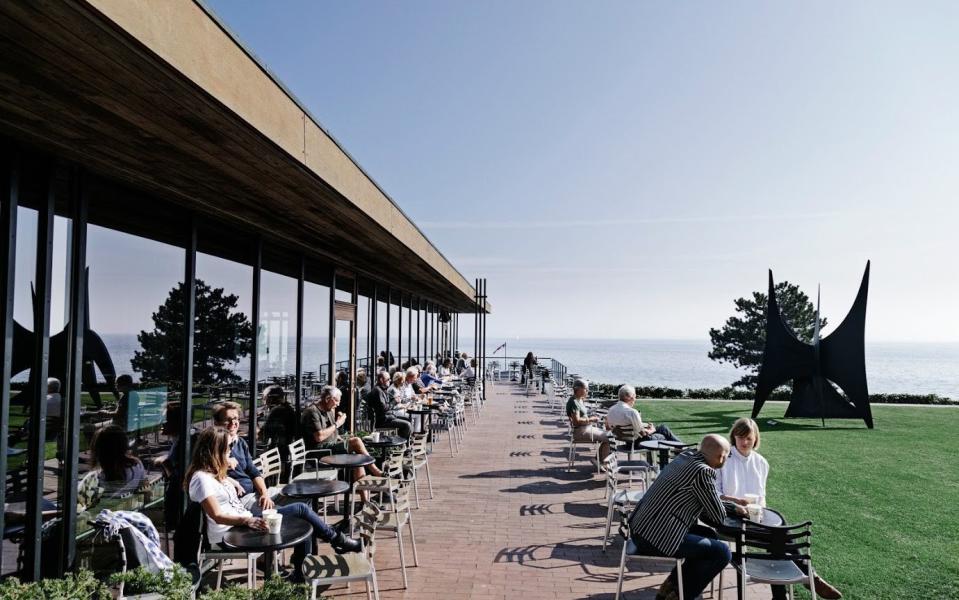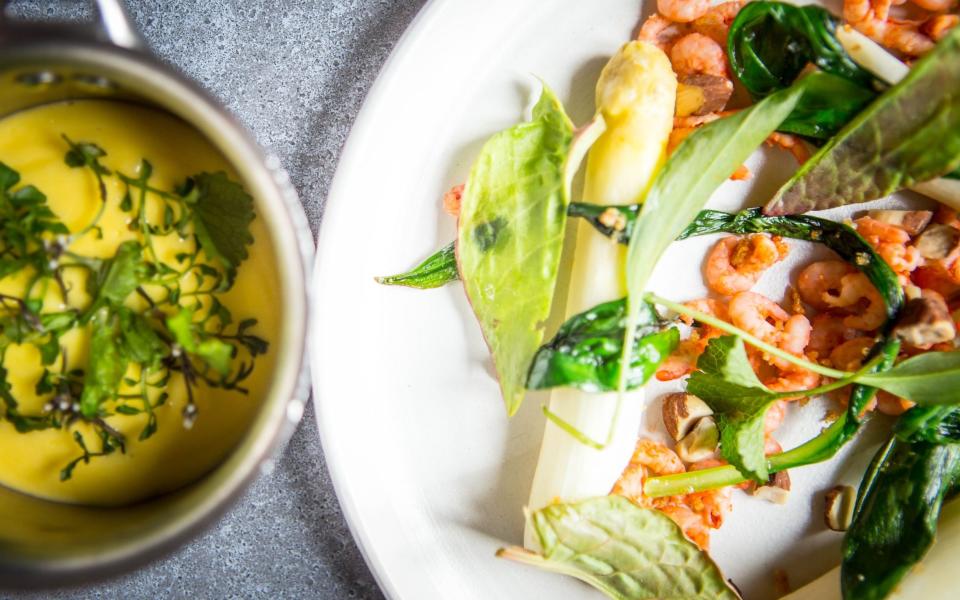Europe's underrated answer to the Hamptons

I felt ridiculously happy and carefree as I pedalled along the seashore path bordered with wild roses and rosehips. The sun was strong even in September, the sky brilliant blue, the coastline strung with quaint fishing villages, each with their own marina, plus near endless peaceful sandy coves. The Danish Riviera I discovered is pristine perfection and best explored, slowly, Danish style, by bike. Two wheels are treated with utmost courtesy here, making it feel safe to explore wheeling it. Imagine the St Tropez of Roger Vadim’s ‘And Man Created Woman’ with Brigitte Bardot flung into a Scandi present.
A mere hour north of Copenhagen by train and a popular summer destination among in-the-know Copenhageners, as The Hamptons are for New Yorkers, it is seemingly utterly unspoilt and understated, with no ugly developments whatsoever. The Danish Riviera, the coastal region of North Sealand from Rungsted to Hundested, is all about meandering among nature and beaches, past hollyhock-fronted thatched cottages with curious peg-like structures holding the roofs in place, stylish expensive looking Nordic villas, and plenty of ultra-modern builds too plus plenty of cultural and gastronomic allure. It is blissfully quiet too.

Our first stay at Villa Brinkly, Snekkersten, was instantly welcoming and familial. The interior could have been straight out of a Scandi Country Living. We were encouraged to help ourselves to homemade biscuits and tea served in vintage china whenever we wished in the dining room (decorated in the kind of pared back Scandi colours I long to be able to reproduce, embellished with quirky seaside decoration). My partner Stephen may well have set a new record in his tea habit at Villa Brinkly. Meanwhile, I rejoiced in trying out all the different seating options in the beguiling garden backing onto forest with raised planters of tomatoes, peppers, and masses of vibrant cutting flowers.
Slow is the modus operandi of Inntravel’s cycling holidays. The itinerary for our self-guided meander arrived in a smart and impressively detailed giant folder a few days before we travelled. A gentle cycle to Helsingor for some foodie exploration was our first outing on our hired e-bikes – the ‘e’ element being advisable, as contrary to expectation, Danish terrain is not always flat. We stopped in the charming main street with lots of rust and ochre-coloured, half-timbered shops and cafes for coffee and flodeboller. We marvelled at Kronborg, the huge medieval castle that dominates the town and the narrow sea, Øresund, between Denmark and Sweden. There is compelling evidence Shakespeare may have visited Helsingor and been inspired by its castle to write Hamlet. Some of his actor friends certainly performed at Kronberg. The receipt for their fee is still in the castle archives.
Our first dinner at Restaurant Streijf (restaurant-streijf.dk) was, fittingly, in the splendidly grand old railway station with views to the port and Kronborg Castle. The Danish Riviera first became so named when the railway was extended from Copenhagen to the coast at the turn of the twentieth century. The menu at Streijf epitomises contemporary Danish cuisine: pure clean tastes with an emphasis on well-sourced ingredients of exemplary provenance. It may not be as attention grabbing as World’s 50 Best Restaurants chart toppers Noma, and, this year, Geranium, which have put Danish cuisine on the world culinary map, yet it is all the more enjoyable for having a relaxed, hygge feel. We relished Grambogard beef tartare with chive oil, crispy onions and egg yolk cream followed by lemon baked cod with homemade creme fraiche, pickled cucumbers and radishes.
Our second day was devoted to wallowing in the joys of the Louisiana Museum of Modern Art (louisiana.dk), with its magical setting right on the coast – my favourite art museum bar none for the way it strikes the rarest of balances between landscape, architecture and art. There’s an impressive permanent collection including works by Francis Bacon, Picasso, and Andy Warhol along with show-stopping Giacometti figures placed in a high room where the vertical windows over the gardens emphasise their lankiness. It’s a place to discover key Scandinavian artists, and there are invariably vanguard special exhibitions.

A big attraction is the outstanding cafe looking over the gardens, which themselves tumble down to the sea full of sculptures by world-renowned artists, including Alexander Calder and Henry Moore, and the shop, which has a brilliant collection of home design and fashion too. From the museum, it is only a short cycle to the beguiling fisherman’s village of Sletten, where we headed next for dinner in Restaurant Sletten (formelfamily.dk), a former inn overlooking the harbour, and now one of the most sought after dining rooms in North Sealand. The menu offers small dishes from salted scallops with lightly smoked new potatoes and lovage, to roast monkfish, cabbage, crispy chicken skin and morel sauce.
Karen Blixen, author of Out of Africa, adored the Danish Riviera and her elegant family home in Rungstedlund, which is now a thoughtfully conceived museum with many rooms – including the pale green kitchen – still exactly as she left them (blixen.dk). Our route there (all along dedicated bike paths – Denmark’s good like that) hugged the coast, with only allotments and wooden jetties – some private and gated, one with a little thatched summer house – breaking up the serene shoreline. At the house, we happily lingered over the resplendent garden of cutting flowers, still arranged freshly every week as Blixen liked them (she once said she couldn’t “imagine a life without flowers”), then over its cafe’s impeccable smorrebrod and cakes.
There’s culinary innovation, too, among restaurants on the Danish Riviera, thanks to young chefs keen to establish their style away from the frenzied competition of Copenhagen. One-year-old Restaurant MOS (restaurantmos.dk) – set in a pretty square in Helsingor – came highly recommended, and we soon saw why. The dishes are intensely seasonal, sustainable and vibrant, from fresh peas with buckwheat, pickled elderflowers and sour cream, to trout with tiny herring, chive flowers and smoked miso.

Even our longest cycle ride – 32 km between Slettenger and Gilleleje – wasn’t too arduous, largely thanks to the delightful cafes offering coffee and homemade cake en route (though the e-bikes might’ve helped a bit, too). And even if it had been, every pedal would have been worthwhile. I fell immediately in love with Gilleleje – a town with an unmistakable buzz, full of alluring independent shops ideal for food-centric purchasing (the licorice! The beautiful tins of Danish mussels!) and, in the case of my favourite discovery, gorgeous boutique AB Hand, handmade artisan crafts from ceramics to jewellery.
Gilleleje even has an honourable footnote in the history of World War II: when the Germans invaded from the south, Jews from Copenhagen fled north, and hundreds of Jewish refugees were concealed in the roof of Gilleleje church. Local fishermen, at great risk to their own lives, smuggled them to Sweden, hidden below deck in their schooners, and their bravery is commemorated at a small museum by the port.
Despite its modest size, Gilleleje is the most important active fishing port in North Sealand, and many of the fishmongers sell to the public. Consequently, this was where I finally got to try some herring – marinated in apple and beer – albeit on a paper plate. But the very best feasting of the trip was still to come – at Restaurant Gilleleje Havn (gillelejehavn.dk), where I tasted Gilleleje’s very own heavenly lobster, found only in its local waters. Danish philosopher Søren Kierkegaard is celebrated for his musings on nature’s sublime effect, and how through tranquillity, one can obtain higher enlightenment. Surely, he must have had the Danish Riviera in mind: a place where time is allowed to stand still – almost.
Eat while you're there

Smorrebrod
These open-topped sandwiches had their origins in the Scandinavian countryside. For nineteenth-century agricultural workers, lunch was simply cold cut leftovers from the previous night’s dinner on a slice of rugbrød, instead of a plate. My favourite was a small fried plaice with mustard, pickle, tarragon and dill-rich remoulade served at the cafe at Karen Blixen’s museum. Other toppings include chicken salad with bacon, mushroom and asparagus, roast beef with horseradish mayo and crisp fried onions or potato salad with cornichons, crisp fried onion, raw onion and creme fraiche.
Fjordrejer
Tiny summer shrimps from the Danish fjords are, to the Danes, what oysters are to the French: an absolute culinary delicacy. They are usually bought alive, cooked and peeled whilst still warm and served on white bread with dill. Chef Anders Dolleris at Restaurant MOS in Helsingor used fjordrejer in a creamy sauce in a brown butter fried crisp wafer.
Flaeskesteg - pork neck roast with crispy pork rinds
Pork neck roast with perfectly crisp straight rinds of crackling or flaeskesvaer is a Danish traditional treat usually served with caramelised roast potatoes and red cabbage. At Louisiana Museum’s Cafe serves it hot with potatoes, pickled tomatoes and creamy mushroom sauce, or cold with apple compote, mustard cream, pickled red onions and crackling.
Lobster
Gilleleje has its own lobster, fished only in local waters, often referred to as Norwegian lobster, akin to giant langoustine or Dublin Bay Prawns. The meat in the head and tail is gleefully white, firm and sweet. At Restaurant Gilleleje Havn, whose co-chef-proprietors are Danish and Thai, a quad of lobster is served sizzling in a copper pan with a kaffir lime-infused dressing.
Rabarbekage - rhubarb cake
Rhubarb is mixed with cinnamon sugar and folded into a lemon zest-flavoured batter to make traditional Danish rhubarb cake, best served with generous whipped cream as at Cafe Strandhuset Nisa, which has a real white sand floor inside as well as a terrace overlooking Nisa’s harbour (cafestrandhuset.dk).
Flodeboller
Chocolate-covered marshmallow puffs on biscuit and marzipan bases: a childhood favourite for most Danes (like Tunnock teacakes, but more svelte).

 Yahoo News
Yahoo News 
